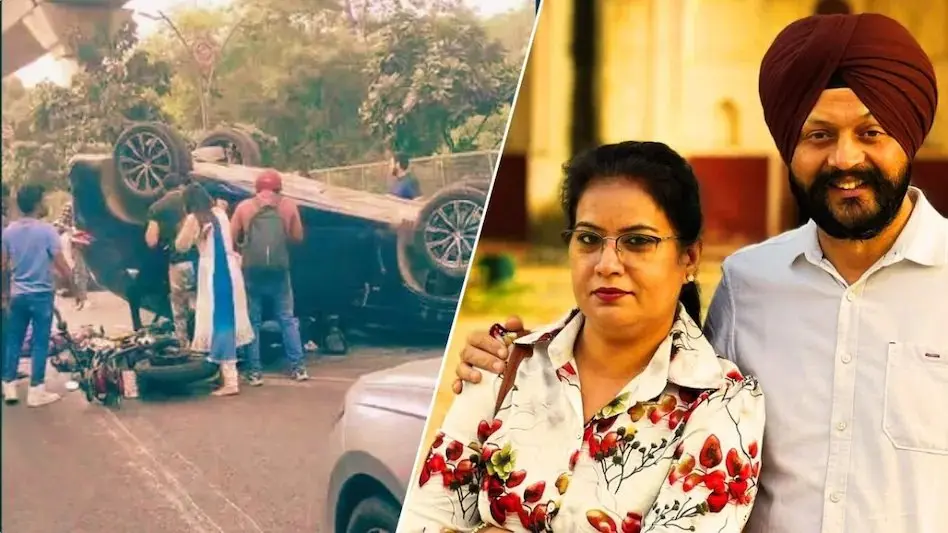
Delhi BMW crash exposes troubling hospital ties, delayed emergency care, and rising public anger as police question accused Gaganpreet and her husband (photo-X@aajtak)
A Deadly Collision and a Mysterious Detour
Twisted Turns in Delhi BMW Crash: How a Tragedy Unfolded and Raised Alarming Questions – On September 14, 2025, a tragic accident near Delhi Cantonment Metro Station shook the capital. A BMW, allegedly driven by 38-year-old Gaganpreet Kaur, rammed into a motorcycle carrying Navjot Singh, a Deputy Secretary in the Ministry of Finance, and his wife, Sandeep Kaur. The couple was returning home from Bangla Sahib Gurudwara when the crash occurred.
The impact was brutal. The BMW first hit a road divider, then collided with the motorcycle, which in turn struck a DTC bus. Navjot Singh died on the spot, while his wife suffered serious injuries. But what followed was even more disturbing.
Instead of rushing the victims to the nearest hospital – AIIMS, Safdarjung, or RR Hospital, Gaganpreet directed a bystander driving a van to take them to Nulife Hospital in GTB Nagar, nearly 19 kilometres away. This decision raised eyebrows immediately. Why bypass multiple well-equipped hospitals in favour of a smaller, less-known facility?
The Hospital Connection: A Web of Familiar Faces
As the investigation deepened, Delhi Police uncovered a startling link: Nulife Hospital is co-owned by Gaganpreet’s relatives. Her father is reportedly a director, and her cousin helps manage the facility. Gaganpreet later told police she panicked and chose the hospital because her children had been treated there during the COVID-19 pandemic.
However, Sandeep Kaur, the injured wife, told police she repeatedly begged Gaganpreet to take them to a nearby hospital for urgent care. Her pleas were ignored. Instead, the couple was taken to Nulife, where Singh was declared dead and Kaur was kept on a stretcher for an extended period.
This choice of hospital has sparked allegations of evidence tampering. Critics argue that Gaganpreet may have chosen a familiar facility to control the narrative or delay official procedures. The “golden hour” after an accident is critical for survival, and bypassing closer hospitals may have cost Singh his life.
Arrests, Interrogations, and a Growing Legal Storm
Gaganpreet was arrested and sent to two-day judicial custody. She faces charges under the Bharatiya Nyaya Sanhita, including culpable homicide not amounting to murder, rash driving, and destruction of evidence. Her bail plea claims she had no intent to harm and that she cooperated fully with the investigation.
Her husband, Parikshit Makkad, was also questioned by police. He told investigators that Gaganpreet informed him she was taking the victims to a hospital, after which he called his father-in-law and left for the hospital in a separate taxi. Police are now verifying his statements and may summon him again.
Meanwhile, forensic teams have begun analyzing the Delhi BMW crash for damage patterns and mechanical faults. The car has been seized and is under inspection at Delhi Cantt Police Station.
The victim’s family is demanding answers. They believe Singh could have survived if taken to a nearby hospital and are calling for a full audit of Nulife Hospital’s role in the incident.
Public Outcry and the Call for Accountability
The Delhi BMW crash has sparked widespread outrage. Citizens are questioning not just the accident, but the decisions made afterward. Why was a critically injured man taken so far from the crash site? Why did the accused choose a hospital linked to her family? And why did it take nearly 10 hours for an FIR to be filed?
Social media is ablaze with demands for justice. Civic groups are urging the Delhi government to enforce stricter protocols for accident response, including mandatory routing to the nearest trauma centre. Legal experts are also calling for transparency in hospital affiliations and emergency care standards.
This case has exposed a troubling gap in India’s accident response system. It’s not just about reckless driving, it’s about what happens next. The choices made in the minutes after a crash can mean the difference between life and death.
The Delhi BMW crash is no longer just a tragic accident, it’s a test of accountability, ethics, and justice. As investigations continue, the city watches closely, hoping that truth will prevail and that future victims won’t be failed by the system meant to save them.
Also read: Mumbai Train Tragedy: 5 Dead as Overcrowding Leads to Fatal Accident
Stay informed with the latest news and updates – only on Rapido Updates.